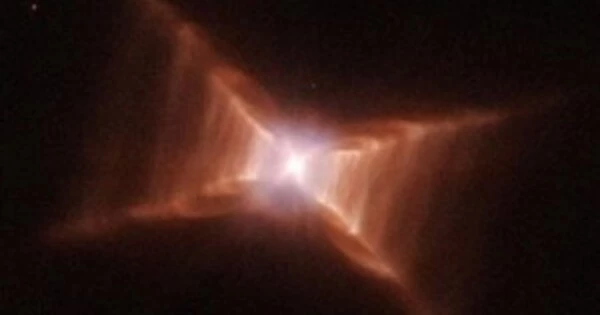The Red Square Nebula is a planetary nebula located in the constellation of Pisces, it is known for its distinctive, square-shaped appearance in images and its red color, which comes from the glowing clouds of gas and dust surrounding a dying star. It is a relatively young planetary nebula, thought to be only a few thousand years old, and is of interest to astronomers due to its unusual shape and the processes that led to its formation.
The Red Square Nebula is a celestial object located in the constellation Serpens, near the star MWC 922. The first images of this bipolar nebula were released in April 2007 using the Mt. Palomar Hale telescope in California. It is notable for its square shape, which makes it one of the most nearly discrete-symmetrical celestial objects ever imaged, according to Sydney University astrophysicist Peter Tuthill.
It is located in the constellation of Serpens and is approximately 2,000 light-years away from Earth. The red color is caused by the emission of light from hydrogen gas as it is excited by ultraviolet radiation from the central star. The square shape is thought to be the result of a dense toroidal structure around the central star, which is shaped by winds and radiation from the star. It is called a “square nebula” due to its unique shape, which is a result of the interaction between the central star and the surrounding material. The central star is emitting a strong wind that pushes the material outwards, creating a square shape. The red color of the nebula is due to the glowing hydrogen gas that has been ionized by the intense ultraviolet radiation from the central star.

The Red Square Nebula is thought to be a result of the intense outflows of gas and dust from an aging star as it transitions into a white dwarf. The bright central star, which illuminates the surrounding gas, has a temperature of around 100,000 Kelvin. The Red Square Nebula is one of the few planetary nebulae with a well-defined square or rectangular shape, making it a unique and interesting object for astronomical study.
Tuthill and his Cornell University collaborator James Lloyd propose that the square shape is formed by two cone shapes placed tip-to-tip from the side. This also accounts for the “double-ring” structure observed in SN 1987A. From the center of the structure, a series of faint spokes radiate. One theory is that these spokes are shadows cast by periodic ripples or waves on the surface of an inner disk near the central star.












